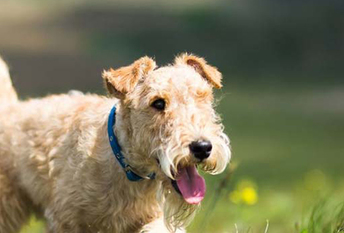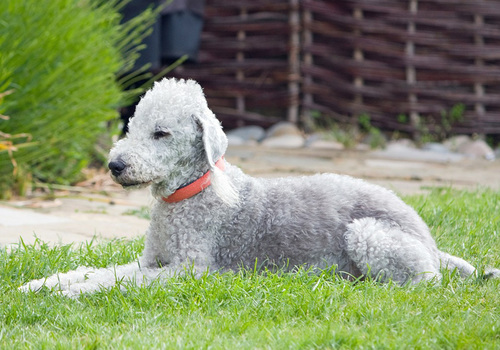The Bedlington coat is a mixture of hard and soft hair with a texture that is crisp but not wiry. It tends to curl, especially on the head and face.
The distinctive look of the Bedlington, with the Mohawk-type head style and shaved ears, doesn’t come naturally. It is achieved through regular grooming, including bathing, brushing, and styling. The Bedlington’s coat must be trimmed every six to eight weeks to maintain its look. Brush it once or twice a week. Frequent bathing and heavy conditioners are not recommended because they will soften the coarse coat.
The Bedlington’s unique hairstyle may look simple, but it is not for beginners. It is best to take him to a professional groomer who is familiar with the breed unless you are extremely ambitious and skilled. If you want to learn how to create it, apprentice yourself to a Bedlington breeder or show dog handler. The Bedlington Terrier Club of America gives a detailed explanation on its website of how the dog should be groomed for the show ring.
Check the ears on a weekly basis for signs of infection, irritation, or wax build up. Cleanse regularly with a veterinarian-approved cleanser and cotton ball. Brush the teeth at least once per week to prevent tartar buildup and fight gum disease. Additionally, nails should be trimmed once per month if the dog does not wear down the toenails naturally.
Bedlingtons, like mostTerriers, have a fair amount of energy and require regularexerciseto stay fit and happy. The breed is energetic, but not rambunctious or mischievous. A Bedlington loves to play fetch or go on a long walk or run, but afterward, he’s happy to just curl up on the couch with his family. Despite their lamb-like looks, Bedlingtons were bred to chase small animals, and that’s what they do. So they require a fenced-in yard and should be on a leash for all walks. Many Bedlingtons enjoy participating inagility,obedience,tracking, and earth dogcompetitions.
With this said,Bedlingtonspuppies should not be given too much exercise because their joints and bones are still growing and too much pressure on them could result in causing a dog a few problems later on in their lives. They should not be allowed to jump up or off furniture nor should they be allowed to run up and down the stairs because this puts too much pressure on their still growing joints and limbs.
Walking/Jogging:Two 20-minute walks (or 10-minute jogs) per day is a good target
Fetch/Frisbee:These dogs will chase a ball, stick, or Frisbee for hours
Hide-and-Seek:Great indoor, rainy-day activity; give the dog a treat when it finds you
Canine Sports:BTs can excel at obedience and agility trials, flyball, and other events
Blowing Bubbles:Your BT will love "attacking" the bubbles you blow
If you get aBedlington puppy from a breeder, they would give you a feeding schedule and it's important to stick to the same routine, feeding the same puppy food to avoid any tummy upsets. You can change a puppy's diet, but this needs to be done very gradually always making sure they don't develop any digestive upsets and if they do, it's best to put them back on their original diet and to discuss things with the vet before attempting to change it again.
Older dogs are not known to be fussy or finicky eaters, but this does not mean you can feed them a lower quality diet. It's best to feed a mature dog twice a day, once in the morning and then again in the evening, making sure it's good quality food that meets all their nutritional requirements. It's also important that dogs be given the right amount of exercise so they burn off any excess calories or they might gain too much weight which can lead to all sorts of health issues. Obesity can shorten a dog's life by several years so it's important to keep an eye on their waistline from the word go.
Treatscan be an important aid in training, but giving too many can cause obesity. Learn about whichhuman foodsare safe for dogs, and which are not. Check with your vet if you have any concerns about your dog’s weight or diet.Clean, fresh water should be available at all times.
The Bedlington is generally a healthy breed, andresponsible breederswillscreentheir breeding stock for health conditions such as hip andelbow dysplasia, hypothyroidism, von Willebrand’s disease (a bleeding disorder), thrombopathia, and certain eye issues. As with all breeds, a Bedlington’s ears should be checked regularly, andthe teethbrushed daily.
Early socialization andpuppy trainingare recommended for all dogs. Though Bedlingtons can be stubborn, they are also both intelligent and eager to please. Bedlingtons do not respond to harsh training methods or physical correction, which can lead to a battle of wills rather than to obedience. Positive-reinforcement techniques, such as using praise and food as rewards, are much more successful.
Puppies should be properly socialized to develop the amiable, outgoing personality that is characteristic of the breed. They’re successful in performance and companion events such as earthdog, barn hunt, obedience, and agility.











